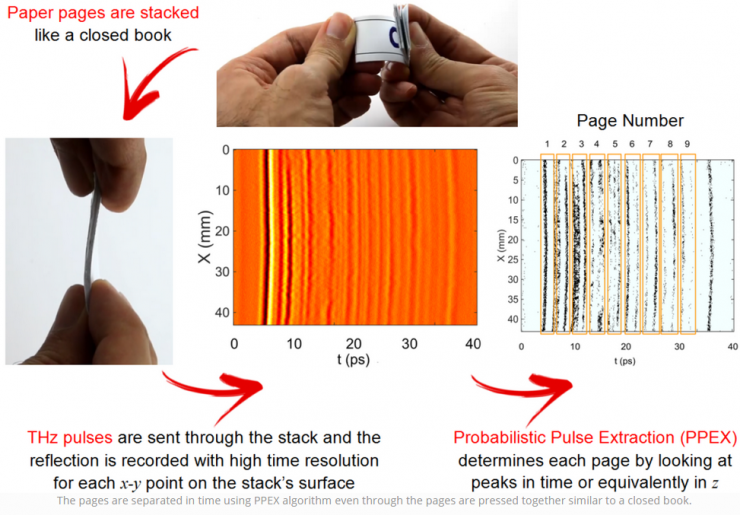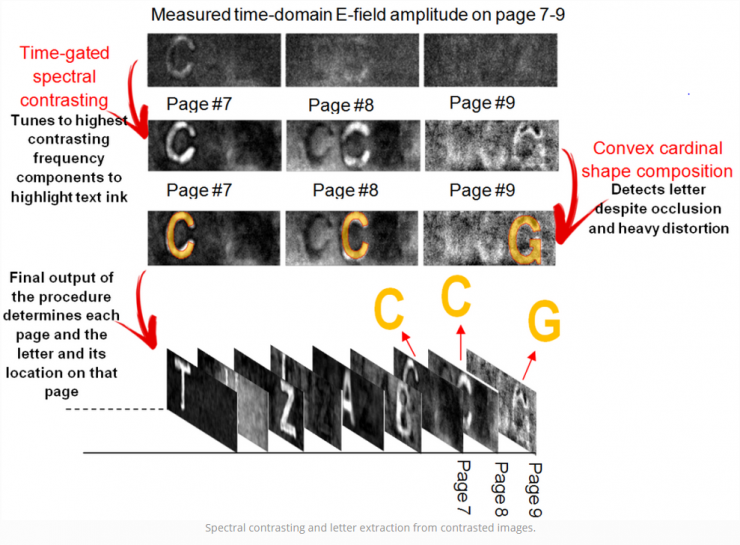Editor's note : At first glance the title of the article, everyone will surely think of it: "Isn't it amzing that computers can read through a book page by page without opening it"? Seriously, the author of our article, from MIT Researchers AR Sanchez, B. Heshmat, A. Aghasi and others of the Media Lab will elaborate on how to use the THz time-horizon spectral imaging technique to extract texts from a layered structure, such as a closed culturally rich ancient book. Content . Unlike X-ray or ultrasound, this imaging technology can discriminate between page-to-page, blank page and text-only pages, and read through the contents of nine pages of paper. At present, researchers are continuing to work hard to achieve technological breakthroughs and improve the practical application of this technology in industrial and cultural heritage research.
In the traditional sense, the time-of-flight imaging technique is generally applied to fast imaging (Femto photography) and complex geometry imaging (such as imaging in a corner or in a diffuser). Since the speed of light closely links time and space, the higher the time resolution, the greater the spatial resolution. In our latest study, we will select a frequency band that can penetrate paper or other materials from 100 gigahertz to 3 terahertz. We will also sample light pulses with very high time resolution (10 megabits per second), and the resulting light pulses will be more than 20 times the light pulses used in our previous studies. This high temporal resolution raises the spatial resolution to about 30 microns, making it possible to separate the pages of a co-authored book from the page. We propose an extended algorithm to make this imaging method (which can be called terahertz time-domain spectroscopy) both imaged and read through dense layered structures. This kind of imaging technology can of course be applied in industrial inspections, but it can also be used to read through closed ancient documents or examine culturally valuable books.
Non-invasive inspections of some complex samples, such as closed books, presently face three major bottlenecks in imaging technology: spatial resolution, spectral contrast, and occlusion. We use the time-of-flight capabilities of traditional terahertz time-domain spectroscopy techniques, combined with their spectral capabilities, in an attempt to overcome these technological bottlenecks in algorithms. According to our research report, it is possible to successfully unsupervisedly extract the contents of a dense layered structure similar to a closed book.
Based on the statistical results of the reflected terahertz electric field, our technique uses similar time-of-flight measurement methods to locate each page in the book. After the layer is positioned, we use a new time-gated spectrum analysis method that can adjust the frequency of each page to correspond to the highest-contrast frame in the spectral domain. As the number of pages increases, the research method we use can produce a level of highlighting that sorts every page. When using a recently proposed method that can identify the occluded letters on each page, the entire imaging process is completed. The experimental results show that we have been able to successfully extract letters from at least 9 pages of paper with text.
Due to the countless layered structures in the industry, each layer is about a millimeter thick, and countless texts rich in cultural values ​​(such as documents, books and works of art), using THz TDS (terahertz time domain spectroscopy) Technology) has broad application prospects for extracting content from a layered structure. Therefore, our research will help to improve THz and other temporal resolution imaging techniques for extracting content from lamellar structures.
Our research confirms the practical application of terahertz time-grating imaging technology in extracting depth content, and points out new research directions for imaging and sensing research. Our findings are reported below:

1. Compared with the traditional deconvolution technique, the electric field statistics of the THz TDS can improve the accuracy of deeper layer positioning. In addition, the application of this technique in extracting pulses does not rely on a reference measurement standard.
2. The time-of-flight capabilities or temporal resolution of terahertz time-domain spectroscopy techniques can be used primarily to resolve 3D spectral features in space (rather than purely transform harmonic analysis of the entire sample). This will help us to adjust the slight spectral differences between the inside of the text and the blank page to achieve the purpose of highlighting the text.
3. The currently proposed calculation methods, such as the basic convex shape decomposition, can obtain completely new applications by accurately recovering the occluded content.

In addition, our technology has had a major impact on the following three areas: ultrafast imaging, computational imaging and terahertz spectral imaging . We hope that our findings will inspire readers to have a keen interest in terahertz time-slicing imaging technology, and at the same time build a new platform for examining layered structures and layered structures. This study will have a profound impact on industrial imaging, seismic imaging research and cultural heritage research. In addition, because this imaging method is based on the image, its application will be extended to the use of other types of time-of-flight sensors in long-distance imaging studies.
The reader may be interested in some of the issues related to this article, and we briefly mention four here:
1. How does our research relate to camera future's "mega-frame imaging per second" research project?
We use similar ultrafast imaging methods to locate each page. Based on the measured time of arrival of the terahertz pulse, we calculate the position of each page, and then observe the spectrum of the pulse to determine whether there is ink in a certain position of the page. Camera Future's “mega-frame imaging per second†project is the first project to apply the ultra-fast setup methods commonly used in physics to imaging systems and applications.
2. Can X-Ray or Ultrasound fail to quickly extract content from a layered structure?
It seems that X-rays or ultrasound can also be read through the book and imaged; however, compared to our THz technique, this type of technique cannot be contrasted between submicron pen ink or pencil layers and blank pages. There are other drawbacks to this type of method, such as high cost and ionizing radiation. If you use CT, it will be difficult to detect the difference between a page and a page in a closed book, and you will not be able to see the text. However, our far-infrared time-resolved system is based on the absorption spectrum of paper, and this imaging technology will be the only technology used to extract textual content one by one.
3. What is the innovation of this THz TDS imaging technology?
The core contribution of this technology is:
1. Use THz signal statistics to extract a layer of text content. Compared with traditional methods, this new technology can be applied to more and lose content extraction.
2. Use the spectral contrast of Kurtosis to adjust the subtle difference between the blank paper and the paper frequency domain with ink.
3, convex basic shape matching, can detect the occluded letters.
4. We apply all of the above-mentioned techniques in order to use computational methods and use the spectral resolution and temporal resolution of the THz time domain spectroscopic system to achieve new applications.
4. What are the limitations of this technology?
SNR vs. spectral contrast is currently the main technical bottleneck; a system with higher performance will help us to “deeper†reading. Another limitation is the deformation of thin paper. Distortion of the paper will lead to distortion of the signal. Our research has recently been resolved to solve this problem.
Original link
Via AR Sanchez et al.
This article is compiled by Lei Feng Network (search "Lei Feng Network" public number) exclusive compilation, refused to reprint without permission!
The QNP Steam Turbines` capacity mainly covers 200MW and below. Our normal impulse turbines are flexible and diverse in structure and layout so as to meet various requirement of our users. Aiming at the global leading equipment manufacturing enterprise, our design and R&D standards are higher than GB standard and in the same league with European and American energy equipment manufacturers.
Condensing Steam Turbine, back pressure steam turbine
Shandong Qingneng Power Co., Ltd. , https://www.steamturbine.be